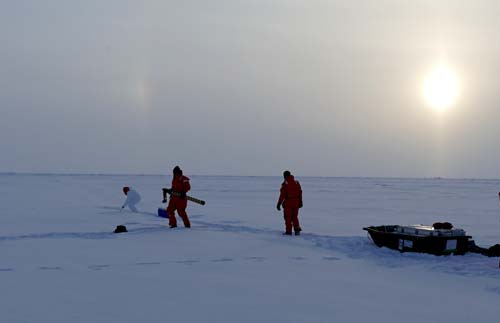Cruise Day 32
Speed 5 knots (kts) Course 152° (SSE) Location Lomonosov Ridge Depth 2749 m
GO DEEPER DISCUSSION: (see previous journal for the questions.)
Fresh water is less dense than salt water, so if conditions are calm enough (such as underneath an ice cap), fresh water will pool up on top of salt water.
TODAY’S JOURNAL:
We are transiting south again after three relatively short stops for repeat hydrography and another to gather dirty ice samples (more on that tomorrow.) As I write, we are about to start looking for another suitable ice floe to disembark onto for a sampling station. First, though, we will conduct a full water sampling station near the chosen ice floe. This will allow direct comparison of data from both operations. It will also mean that we’ll be stopped for a while once we find the spot.
Yesterday I talked about the ice characterization process that Kyle Dilliplaine conducted at our last ice station. Today I’ll follow up that with a discussion of the clean ice sampling that happens at ice stations. By clean ice, I mean that the sampling procedures are all designed to avoid contamination, particularly from trace metals. This is tricky since most tools have metals like iron in them that would throw off the minute amounts of the element that scientists are trying to measure. So care is taken to pick an undisturbed area on the ice that is upwind of the ship (so no engine exhaust reaches the area) and suitably distanced from the other sampling operations. The scientists don’t touch any of the samples, and the tools they use are plastic or if needed, titanium (an element that isn’t being measured in the GEOTRACES samples.)
 A sun dog (bright spot left of the Sun) appeared as the clean ice sampling team was setting up their operation at the North Pole ice station.
A sun dog (bright spot left of the Sun) appeared as the clean ice sampling team was setting up their operation at the North Pole ice station.
 The clean ice sampling area on our North Pole ice station.
The clean ice sampling area on our North Pole ice station.
Ana Auguilar-Islas (Assistant Professor, School of Fisheries & Ocean Sciences, University of Alaska Fairbanks) and Rob Rember (Research Professor, University of Alaska Fairbanks) head up the clean ice sampling efforts, and were assisted by Sara Rauschenberg (Research Associate, Bigelow Lab, Booth, Maine) at our North Pole ice sampling station. Three types of samples are collected by team clean: snow, sea Ice, and sub-ice sea water.
After donning a Tyvek coverall suit, Ana collects clean snow samples using an acid-washed plastic shovel (the acid-washing removes any potential trace metal contamination.) With the white suit on, Ana almost disappears into the polar environment! These samples go into large bags, to be melted aboard for analysis or preservation for labs ashore.
 Ana Auguilar-Islas collects snow following clean GEOTRACES protocol at our North Pole ice sampling station while Sara Rauschenberg records field notes.
Ana Auguilar-Islas collects snow following clean GEOTRACES protocol at our North Pole ice sampling station while Sara Rauschenberg records field notes.
Rob extracts core samples with a drill similar to the one Kyle uses for his samples. A few key differences should be noted, however. First, the entire coring cylinder is plastic, with titanium cutting teeth. Secondly, the drill has a plastic tube inside where the cores enter. The tube is slid out of the coring cylinder and capped without anyone handling the ice inside. Finally, these cores aren’t taken all of the way through the ice, to avoid contamination with sea water. Ice from these clean cores is brought aboard for melting, after which it is analyzed similarly to other GEOTRACES water samples from the GoFlo bottle rosette we cast on a regular sampling station. Rob wears clean boot covers for this operation but doesn’t need the full suit, since the plastic core tube protects the sample from whatever is hitchhiking out with Rob on his clothes.
 Rob Rember drills a sea ice core with his trace-metal clean coring drill at the North Pole.
Rob Rember drills a sea ice core with his trace-metal clean coring drill at the North Pole.
 After drilling a core, the GEOTRACES clean ice sampling team extracts the plastic core tube, caps the tube, and bags the sample to keep it clean prior to returning it to USCGC Healy.
After drilling a core, the GEOTRACES clean ice sampling team extracts the plastic core tube, caps the tube, and bags the sample to keep it clean prior to returning it to USCGC Healy.
For the sub-ice water samples, an ice-fishing tent is set up over a hole that Kyle drilled for the team earlier. This tent has no floor, and shelters the pump, water bottles, and scientists inside during their pumping operation. Water is pumped into large containers called carboys from directly under the ice, 5 meters deep, and 20 meters deep. The 20-meter sample crosses over with the GEOTRACES rosette’s shallowest collection depth, allowing comparison of the two data sets. Water returned to the ship from the clean pumping operation undergoes the same kinds of analysis as GEOTRACES samples from the GoFlo bottle rosette.
GO DEEPER!
Why are sun dogs (parhelia) often seen in polar regions in the summer, but in temperate regions they are more commonly seen in the winter?
Aloft Con web cam updated every hour
Healy Track
That's all for now. Best- Bill


Comments